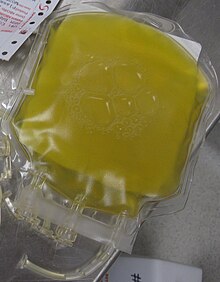
Back Bloedplasma Afrikaans بلازما الدم Arabic لپلازما (فيزيولوجيا) ARY بلازما ARZ Плазма крыві Byelorussian Кръвна плазма Bulgarian রক্তরস Bengali/Bangla Krvna plazma BS Plasma sanguini Catalan پلازمای خوێن CKB

Blood plasma is a light amber-colored liquid component of blood in which blood cells are absent, but which contains proteins and other constituents of whole blood in suspension. It makes up about 55% of the body's total blood volume.[1] It is the intravascular part of extracellular fluid (all body fluid outside cells). It is mostly water (up to 95% by volume), and contains important dissolved proteins (6–8%; e.g., serum albumins, globulins, and fibrinogen),[2] glucose, clotting factors, electrolytes (Na+
, Ca2+
, Mg2+
, HCO3−, Cl−
, etc.), hormones, carbon dioxide (plasma being the main medium for excretory product transportation), and oxygen.[3] It plays a vital role in an intravascular osmotic effect that keeps electrolyte concentration balanced and protects the body from infection and other blood-related disorders.[4]
Blood plasma is separated from the blood by blood fractionation containing an anticoagulant in a centrifuge until the blood cells fall to the bottom of the tube. The blood plasma is then poured or drawn off.[5] For point-of-care testing applications, plasma can be extracted from whole blood via filtration[6] or via agglutination[7] to allow for rapid testing of specific biomarkers. Blood plasma has a density of approximately 1,025 kg/m3 (1.025 g/ml).[8] Blood serum is blood plasma without clotting factors.[5] Plasmapheresis is a medical therapy that involves blood plasma extraction, treatment, and reintegration.
Fresh frozen plasma is on the WHO Model List of Essential Medicines, the most important medications needed in a basic health system.[9] It is of critical importance in the treatment of many types of trauma which result in blood loss, and is therefore kept stocked universally in all medical facilities capable of treating trauma (e.g., trauma centers, hospitals, and ambulances) or that pose a risk of patient blood loss such as surgical suite facilities [10]
- ^ Dennis O'Neil (1999). "Blood Components". Palomar College. Archived from the original on June 5, 2013.
- ^ Tuskegee University (May 29, 2013). "Chapter 9 Blood". tuskegee.edu. Archived from the original on December 28, 2013.
- ^ Mathew, Joscilin; Sankar, Parvathy; varacallo, Matthew (2024). "Physiology, blood plasma". Europe PMC. PMID 30285399. Retrieved January 23, 2024.
- ^ "Ways to Keep Your Blood Plasma Healthy". BloodBanker. Archived from the original on November 1, 2013. Retrieved November 10, 2011.
- ^ a b Maton A, Hopkins J, McLaughlin CW, Johnson S, Warner MQ, LaHart D, Wright JD (1993). Human Biology and Health. Englewood Cliffs, New Jersey: Prentice Hall. ISBN 0-13-981176-1.
- ^ Tripathi S, Kumar V, Prabhakar A, Joshi S, Agrawal A (2015). "Passive blood plasma separation at the microscale: a review of design principles and microdevices". J. Micromech. Microeng. 25 (8): 083001. Bibcode:2015JMiMi..25h3001T. doi:10.1088/0960-1317/25/8/083001. S2CID 138153068.
- ^ Guo W, Hansson J, van der Wijngaart W (May 2020). "Synthetic Paper Separates Plasma from Whole Blood with Low Protein Loss". Analytical Chemistry. 92 (9): 6194–6199. doi:10.1021/acs.analchem.0c01474. PMID 32323979.
- ^ Shmukler M (2004). Elert G (ed.). "Density of blood". The Physics Factbook. Archived from the original on December 9, 2021. Retrieved January 23, 2022.
- ^ "19th WHO Model List of Essential Medicines (April 2015)" (PDF). WHO. April 2015. Archived (PDF) from the original on April 28, 2019. Retrieved May 10, 2015.
- ^ Soffer D (2008). "Usage of Blood Products in Multiple Casualty Incidents: The Experience of a Level I Trauma Center in Israel". Archives of Surgery. 143 (10): 983–989. doi:10.1001/archsurg.143.10.983. PMID 18936378. Retrieved January 23, 2024.
© MMXXIII Rich X Search. We shall prevail. All rights reserved. Rich X Search